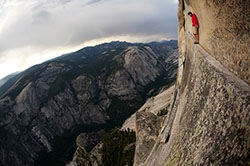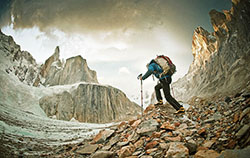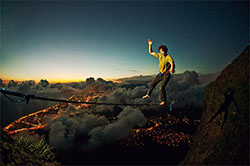
|
|
|||||
|
Featured Photographer, July 2012: Tim Kemple
This month, our featured guest is Tim Kemple. We want to thank Tim for finding time to answer our questions, and share his thoughts, insights and experiences with us! Please visit his site links to see more of his dynamic work, and to let him know you enjoyed this interview. :: How did you get your start in photography? Was it a product of necessity, as with many outdoor photographers who say, "I was in all these great places and wanted to capture it, so I got more into photography." Was the medium there before the adventure or after? I didn't realize it at the time, but as I've gotten older I can say that I grew up traveling and exploring -- especially the mountains. I don't know if it was intentional by my parents, but in retrospect its what has shaped the way I see everything that happens once you step out the front door. I was skiing when I was three, playing on the rocks with my dad when I was 6 or 7. The books I read at a young were guidebooks to the worlds mountains, trails, and climbs... and they were filled with the most amazing black and white images. Photos of mountains, of climbers, skiers. So as I got older, and I started to visit these places, I thought to myself, hey I can do that too, only these will be my own stories to share.
:: Your portfolio is so diverse, how do you approach shooting now as opposed to the early days? I'm sure that as your portfolio has grown, and your reputation for outstanding work, you get asked to do more and more projects. How do you bring your vision and creativity to projects that may or may not be in your favorite areas to shoot? Really, you thinks it's diverse? That's great to hear -- I often get pigeon holed as the "extreme photographer guy." When I first started out I was shooting on a beat up Nikon N90 that I bought with my graduation money from high school. I'd go out with friends and shoot images that I thought the magazines would run. I'd make a little money, go buy some more slide film, or a new lens off eBay and do it all over again. Things are different now, the clients are bigger, but I still haven't lost that passion for creating.
:: What added difficulties do you face when working in the field as an outdoor adventure photographer? Most landscape photographers deal with some of the extremes in terms of the elements, but how do you factor in the added safety issues, as well as putting models into this equation, and still make it work? Most of my work these days is commercial shoots or sponsored expeditions that have a good amount of expectation and responsibility attached to them. It's not like somebody's life is on the line, but my clients put their neck's out there to get the support we need to do these shoots. So I spend a TON of time working with producers to get the right athletes, to the right locations, at the right time of year. Dealing with the weather, personalities, travel, exposure etc are a given any time you get a group of people together to have an adventure outdoors. Turning that adventure into a shoot just adds a bit of pressure and more work... oh and more heavy bags, too.
:: Is there any special lighting or flashes you like to use for shooting people in the field? I've shot speedlights, alien bees, Profoto 7b and Elinchrom Ranger on location, miles from the car. They all have their strengths, e.g., the speedlights are super light, but don't pack the punch of the Elinchrom. The more light you have the more you can modify and play with it using umbrellas, grids and boxes, etc. In general, having the amount of light I need is priority #1, weight is #2.
:: How do you keep your gear safe and functional in extreme cold? On all of our shoots we are carrying our gear in performance based protective bags from Fstop. People ask about the cold all the time and the short answer is I don't do anything. I've been in some wet, cold, and otherwise unpleasant conditions on shoots and I have never had any major issues. Our gear is more durable than we give it credit for. Back in the day we used to break film when loading in the extreme cold, but that's not an issue any more. These days when it's wicked cold I keep an extra battery in my pocket and swap it out periodically with the one in camera.
:: You've mentioned on your site how lucky you feel to be able to work with athletes in these difficult outdoor arenas like mountaineering and climbing. How does that translate into the type of images you make...the images are so interesting in that your knowledge of the sport comes across in presenting these climbers in their element. The images tell stories, but I don't think people may realize that YOU have to be just as skilled in the sport as the people you're photographing. Do you ever get any feelings that the general public might not know how truly hard your job is? I think most people get that the photographer is along for the adventure with the athletes. What I DO think is lost on people is how hard I try to create images that are inspirational to the athletes AS WELL AS marketable for the brand we are doing a shoot for. What it really comes down to is authenticity. I see outdoor images all the time that were shot for a commercial purpose, but would never see the light of day at Powder, Outside, or Climbing magazines. That's the challenge -- go out on a shoot and produce images that are worthy of a two page spread in a core magazine on command. If the client is stoked, cool, but if I can make the athletes stoked too, then I know we're doing something right.
:: Can you talk about the Ennedi project on your website? I found the whole series to be very interesting, and it's not outdoor sport related, so I was left to make up my own story to go with some of these mysterious images (the one with the guy and the light at night in the grass was almost eerie to me, but powerful). What was the purpose of this series? I traveled to the Ennedi (in Chad) on an expedition in November 2010 as the DP for a film about the expedition. Because I didn't have obligations as far as still photography was concerned, I saw it as an opportunity to do a bit of a personal project. I had just picked up a Hasselblad H4D, which is generally considered a studio camera, so I thought I'd see how it'd do on location in a dusty, dirty, windy place in the middle of nowhere. The idea was to capture epic landscapes and intimate portraits of people we met along the way. I lit the portraits with an Elinchrom Ranger in an Octobox and stitched multi image panos together from the massive H4D files. The camera survived quite well and the images while not "extreme" have a great depth to them that I'm really happy with.
:: The Jungle series is obviously an extreme race of some sort. How did you go about photographing a race? My thought would be that once that race started, it would be difficult (more so given the off-road nature) to keep up with the participants. Can you talk a bit about the race, and then how you went about photographing it? The images you are referring to are from "The Jungle Marathon," a multi-day stage race in Northern Brazil that starts inland and follows tributaries, and eventually the Amazon, out to sea. Given that the athletes have to run about 20 miles a day for a week through the jungle and carry all of their own food and hammock, its not the most popular race in the world. But that's also what makes it so bad ass. Every morning the racers would take off from a random starting line and head off into the jungle. My team had a guide that would lead our crew in canoes to places where the race would cross streams and tributaries. When they'd cross, we'd run along shooting photos and video at scenic places. I've never been stung by insects so large, but I'd do it again in a heartbeat.
:: What was the toughest shoot you've been on from a physical standpoint? They are all tough and fun for different reasons.
:: What about a fear standpoint? What was the scariest for you? There has to be some fear involved with the type of photography you do high in the mountains, climbing with the inclement weather, etc. The cameras provide some degree of desensitization, but how do you deal with those fears that I would assume are there for a lot of your work? I think because I grew up exploring, and am lucky enough to hang with the world's best outdoor athletes I am a bit numb to how "out there" we are sometimes. I mean, last year I spent a month hanging in a tent with Alex Honnold, a guy known for climbing the biggest routes in the world ropeless. Hearing his "almost" stories are insane! It's hard to feel extreme when the guy you are swapping stories with literally lives life on the edge every day.
:: You've gotten into videos as well. How did what you've done with still images translate into moving images? What added challenges did it present you? How does it impact your workflow for a project when video is added, as opposed to just stills? I was playing with video cameras before I got into taking stills actually. Shooting the same things -- some stories lend themselves to being pictures, others videos. The way that you engage a viewer, and the tools at your disposal when making a movie compared to making a still image is night and day. The same can be said for the amount of man power required to make a film compared to a single image. Motion is just so much more complex. That's its blessing and curse. Video is powerful, but there's something beautiful about trying to tell a story in a single image. So back to your question. Shooting motion and photos well, by yourself, on a shoot is nearly impossible. Yes you can do it once or twice with a simple concept, but to really produce great content on a regular basis, there just isn't enough time in the day. Recently I've had several successful shoots where I was capturing stills and directing motion. Because so much of a successful photo or video shoot share the importance of great planning, it's been fun to try and find the balance.
:: What current projects are you working on that you'd like people to know about? Nothing specifically. Last year I was on the road for 300 days and this year will be the same. I pour my heart into these projects, so I want people to look at one of my images and be stoked to get after it -- whether they know it's mine or not. There is some new running imagery I shot for The North Face that I am pretty proud of. And there's a campaign for Colorado Tourism that just came out that has a fresh feel that I put a lot of heart into, you should check it out!
:: How often do you climb recreationally or set out to climb a mountain where photography is not the primary focus of the adventure? I imagine, given the work you do, you have to not only keep the camera skills sharp, but also the climbing aspect as well. Keeping up with these athletes is tough, so I do my best to stay in shape. So when I'm not doing interviews [grin]... I'm climbing 4-5 days a week. Skiing about 30 days this past year. I'm on my way back from Japan right now, and on our one down day we got up at 3AM and climbed and skied Mt. Fuji. The best down day ever? I think so!
:: Are there any subjects that you won't photograph? You have a really unique vision that I think translates really well for any kind of subject. If someone wanted you to shoot a wedding, would you? Or is that kind of "formal" environment not interesting? I've been doing editorial portrait projects for Entrepreneur, RedBulletin, etc the past 6 months. They are a good change of pace and a fun way to meet creative people that I wouldn't have had the opportunity otherwise.
:: What do you find the biggest challenge is for you now in photography? Is it too much work? Not enough? Not enough time for personal projects? Finding challenging subjects? Time. Time is the limiting factor. Also learning how to relinquish control, as my business grows, has been a challenge too. You are capable of greater things when you surround yourself with a group of talented people -- you just have to let go to make it happen.
:: How has social media played a part in how you run your business? I'm a big believer in not maintaining a digital entity unless you can produce on a consistent basis. So its taken me a while to get up to speed on Instagram, I don't have a [Facebook] "Fan" page and my blog is only updated on a weekly basis. Its a full time job to keep up -- so I do my best to speak honestly and creatively in a timely way.
:: Favorite place to photograph (or favorite subject)? I love taking photographs of passionate people. If it can be in a beautiful landscape all the better!
:: How do you combine a wonderful landscape with a job like advertising a product, or a sport? What goes into making that combination work so both are given proper weight in the finished image? I'm thinking about the Colorado advertising campaign you recently completed for example. Authenticity. Would it inspire me? Would it inspire my peers? Whether it's action or lifestyle, it's got to be authentic, that's the gauge.
:: Place you haven't been that you're most looking forward to photographing in the future? One word: Iceland. Done.
:: Favorite piece of non-photographic equipment that you can't live without? A nice pair of climbing shoes.
:: Lastly, what advice would you have for someone wanting to pursue a career in adventure or extreme sport photography? Shoot people who inspire you in landscapes that are amazing. Don't copy what has been done before and be a fun person to be around. Easy enough! Or come work for me for a year, I may be looking soon... |
Tim Kemple
 Photographer Spotlight Interviews
|
|
 |
Other Cool Stuff→ Past Workshop Photos → 72dpi.com → How-To Articles → Photographer of the Month |
 |
Contact Us→ Contact Us → About Us → Site Map |
© 2009-2024 Aperture Academy, Inc.








